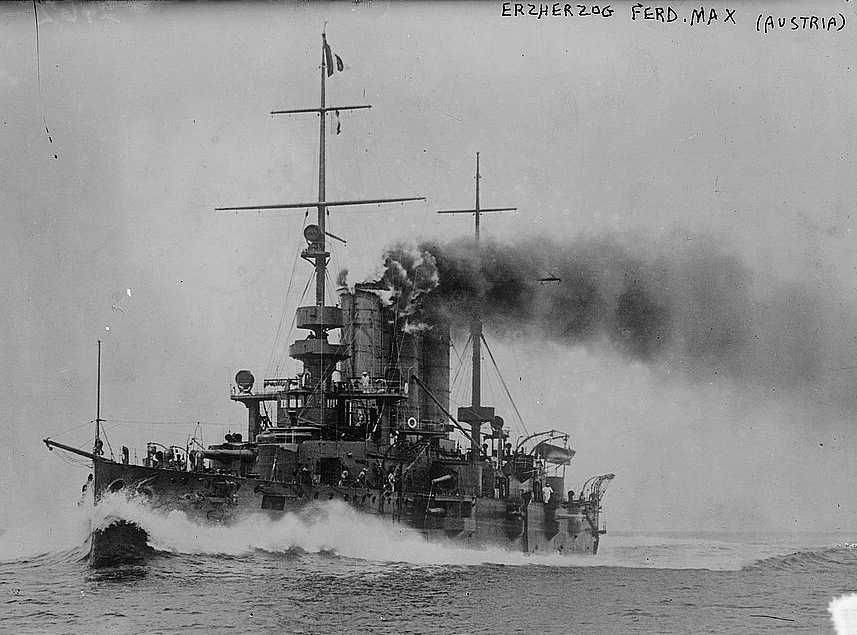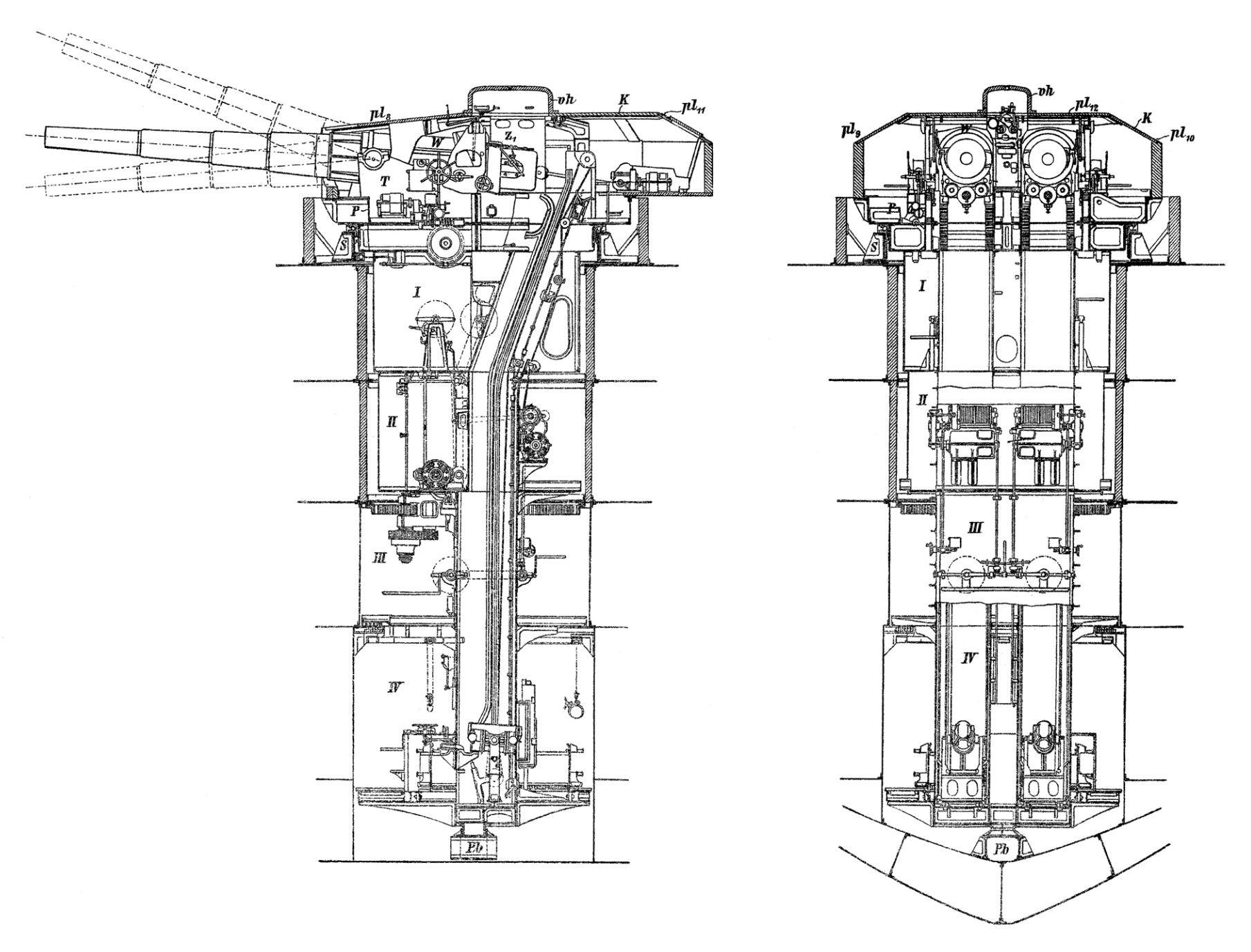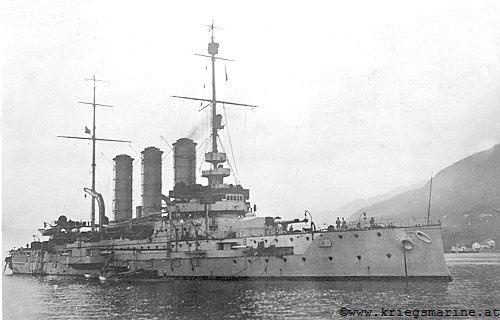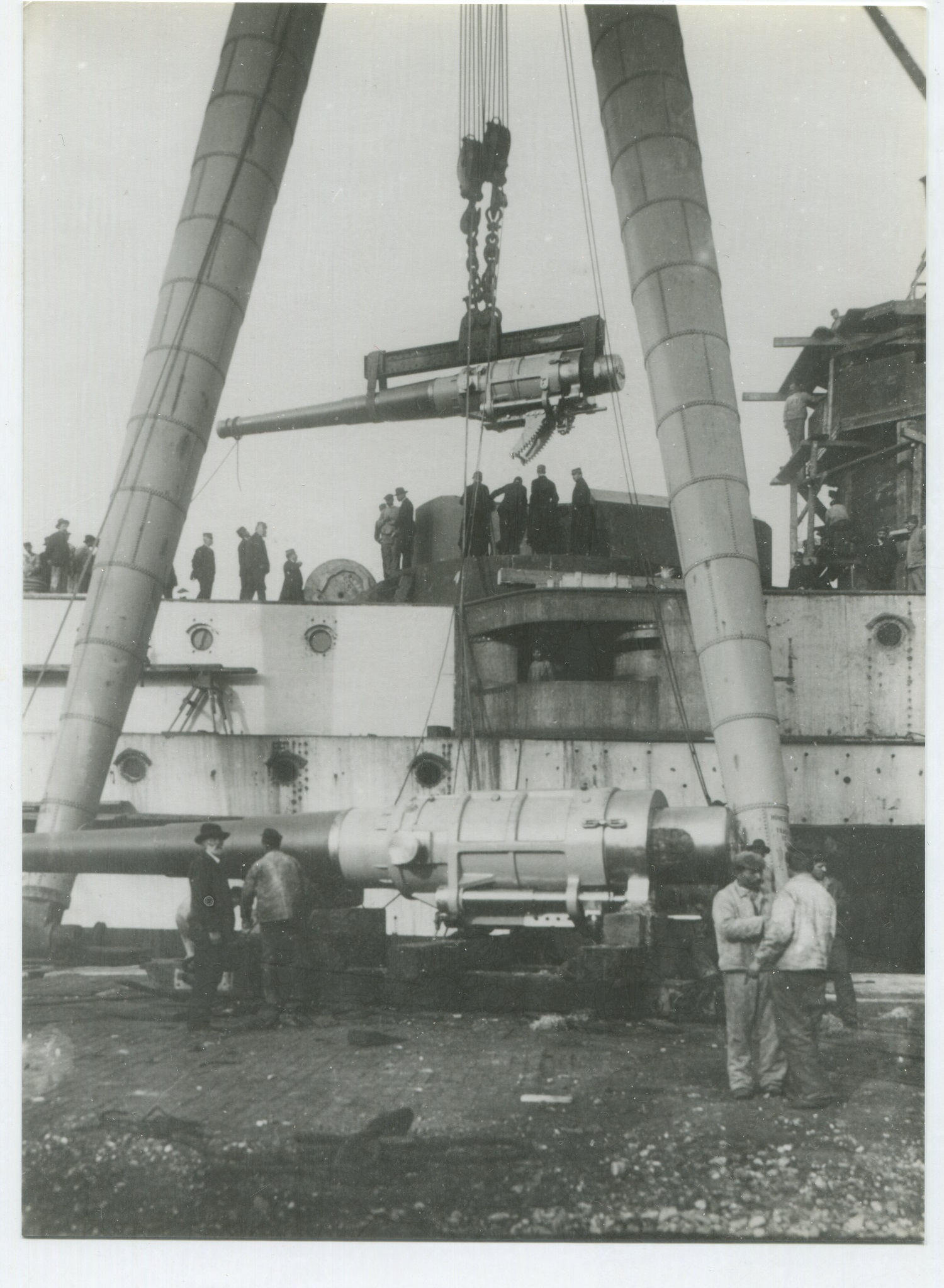
The K97 was a Krupp gun built for Austria-Hungary's Panzerschiffs. The K/01 was built by Škoda to their own design which was similar to but simpler than the K97. The K97 was built of four overlapping tubes while the K01 had three overlapping tubes.
Unlike Krupp 24 cm guns built for the German Navy which had an actual bore of 23.8 cm (9.37"), the bore diameter of all Austria-Hungary guns was 24.0 cm (9.45").
| Designation | 24 cm (9.4") L/40 Krupp K97 1 24 cm (9.4") L/40 Škoda K/01 |
|---|---|
| Ship Class Used On 2 | K97: Habsburg and Árpád as commissioned, Kaiser Karl IV as rearmed in 1916
K/01: Babenberg, Sankt Georg and Erzherzog Karl class |
| Date Of Design | K97: 1897
K/01: 1901 |
| Date In Service | K97: 1904
K/01: 1904 |
| Gun Weight | K97: 29.57 tons (30.042 mt) without breech mechanism and BM 1,451 lbs. (658 kg) 3 K/01: 28.15 tons (28.606 mt) without breech |
| Gun Length oa | 378 in (9.600 m) |
| Bore Length | 349 in (8.866 m) |
| Rifling Length | 286 in (7.277 m) |
| Grooves | (72) 0.059 in D x 0.274 in W (1.5 mm D x 6.97 mm W) |
| Lands | 0.138 in (3.5 mm) |
| Twist | RH increasing 0 to 1 in 25 |
| Chamber Volume | N/A |
| Rate Of Fire | K97: about 2 rounds per minute
K/01: 2.5 rounds per minute |
- ^A Note on Sources: Most references say that the K97 guns were built by Škoda but recent research (2020) by Erwin F. Sieche has determined that these guns were actually made by Krupp.
- ^Data on which ships used which guns is based upon recent research (2020) by Erwin F. Sieche.
- ^A Note on Sources: "Naval Weapons of World War One" on page 286 says that the K97 gun "weighed 307,000 kg [sic] (plus 658 kg breech)" but this is incorrect. "Unterricht für das 24 cm Geschützes L/40 K. K/97" says 30,700 kg is the total weight for the gun and breech mechanism together and 658 kg for the breech mechanism alone.
| Type | Separate |
|---|---|
| Projectile Types and Weights 1a 2a | AP L/3.5: 474.0 lbs. (215.0 kg) 3a APC (length unknown): 505 lbs. (229 kg) 4a SAP L/4.1: 474.0 lbs. (215.0 kg) 3a SAPC (length unknown): 505 lbs. (229 kg) 4a |
| Bursting Charge 5a | AP L/3,5: 5.29 lbs. (2.4 kg) TNT
APC (length unknown): Possibly 5.29 lbs. (2.4 kg) TNT SAP L/4.1: 38.2 lbs. (17.34 kg) TNT SAPC (length unknown): Possibly 38.2 lbs. (17.34 kg) TNT |
| Projectile Length | AP L/3.5: 32.3 in (82.0 cm)
APC (length unknown): N/A SAP L/4.1: 39.3 in (99.7 cm) SAPC (length unknown): N/A |
| Propellant Charge | Full charges
97.1 to 101.7 lbs. (44.05 to 46.15 kg) of 21/700 mm M/97a 1a Reduced charges
|
| Cartridge Case Type, Size and Empty Weight | Brass, 240 x 1031.5 mm, 55.2 lbs. (25.015 kg) including screws and lid |
| Muzzle Velocity | Full charges 1a AP L/3.5: 2,379 fps (725 mps) APC (length unknown): 2,313 (705 mps) SAP L/4,1: 2,379 fps (725 mps) SAPC (length unknown): 2,313 (705 mps) Reduced charges
|
| Working Pressure | N/A |
| Approximate Barrel Life | N/A |
| Ammunition stowage per gun | Habsburg class and Sankt Georg: 80 rounds 6a Others: N/A, but probably about 80 rounds |
- ^1.11.21.3A Note on Sources: There is some disagreement regarding muzzle velocity, shell weight and propellant weight in reference works. The data in the table above comes primarily from the Austro-Hungarian naval documents listed below along with some deductions on our part. At the time of service introduction, the AP and SAP shells had neither AP caps nor ballistic caps. These were introduced starting around 1912-1913, but details are lacking in most cases.
- ^
Actual designations for projectiles AP L/3,5 24 cm Panzergranate L/3,5 APC (length unknown) 24 cm bekappte Panzergranate (length unknown) SAP L/4,1 24 cm Zündergranate L/4,1 SAPC (length unknown) 24 cm bekappte Zündergranate (length unknown)
At the time of service introduction, these shells did not have ballistic caps. They were apparently added during the war. - ^3.13.2The AP L/3,5 and SAP L/4,1 were new designs, replacing the AP L/3,5 and SAP L/4,4 shells used on the older 24 cm guns. The L/4,1 had thicker walls than the L/4,4, which would lead me to believe that the L/4,4 was found to be too weak and so was replaced by the L/4,1. However, in his report regarding the May 1915 bombardment of the Italian city of Ancona, Kontreadmiral Franz Löffler, commanding the three ships of the Erzherzog Karl class, complained about frequent “Geschsskrepierungen” (ammunition failures), as some projectiles broke into pieces shortly after leaving the barrel. Löffler blamed poor manufacturing quality as the cause of these failures. There is a possibility that these failures were old SAP L/4,4 shells being "used up" in this bombardment.
- ^4.14.2The"Unterricht" for the K97 mentions APC and SAPC shells that weighed 229 kg (505 lbs.) but other than that and a range table, this document offers very little information about them. One secondary source, "Sankt Georg: Österreich-Ungarns letzter Panzerkreuzer. Im Dienste der k.u.k. Außenpolitik in Krieg und Frieden" [Sankt Georg: Austria-Hungary's last armored cruiser. In the service of Austro-Hungarian foreign policy in war and peace] by Nikolaus A. von Sifferlinger, states that during the war she was supplied with new shells weighing 229 kg plus a 1 kg ballistic cap. These shells may have been the AP L/3,5 and SAP L/4,1 modified by adding the same 14 kg AP cap that was developed for the newer 24 cm APC and SAPC shells developed for the Radetzky class, but we have not yet found an official document that supports this supposition.
- ^Amatol was substituted for TNT during the war.
- ^Outfit for Sankt Georg was 40 AP/APC and 40 SAP per gun. This was probably the same for the other ships as well.
- The bourrelet diameter was 23.8 cm.
| Elevation | 229 kg shells | 215 kg shells |
|---|---|---|
| 9.15 degrees | --- | 10,940 yards (10,000 m) |
| 16.25 degrees | 13,120 yards (12,000 m) | 15,420 yards (14,100 m) |
| 19.87 degrees | 14,220 yards (13,000 m) | --- |
| 19.90 degrees | --- | 16,730 yards (15,300 m) |
These ranges are for projectiles that do not have a ballistic cap.
It should be understood that the fire control equipment of these ships was unable to use the maximum range of these guns.
| Range | AP | SAP |
|---|---|---|
| 6,000 m | 9.4 in (23.9 cm) | 7.4 in (18.8 cm) |
| 10,000 m | --- | 4.4 in (11.1 cm) |
| 12,000 m | --- | 3.6 in (9.2 cm) |
Data from "Naval Weapons of World War One."
| Range | AP |
|---|---|
| 1,000 m | 11.0 in (28 cm) |
Data from "Naval Weapons of World War One" which also notes that the APC (length unknown) could penetrate (52 cm) of vertical wrought Iron plate at 5,470 yards (5,000 m).
| Designation | Single Turret
Habsburg (1) and Árpád (1): K97 Babenberg (1): K/01 Two-gun Turrets
|
|---|---|
| Weight | K97 single: 133.7 tons (135.8 mt)
K01 single: 203.7 tons (207 mt) K97 twin: 198.8 tons (202 mt) |
| Elevation | K97 single: -4 / +20 degrees
K97 twin: -4 / +20 degrees K/01: N/A |
| Elevation Rate 3b | K97 single and twin: 0.5 degrees per second
K/01: N/A |
| Train | +130 / -130 degrees |
| Train Rate | K97 single and twin: 4.4 degrees per second
Others: N/A |
| Gun recoil | K/01: 23.1 in (58.6 cm) nominal
Others: N/A |
| Loading Angle | +4 degrees |
- ^K97 mountings were electrically powered for training, elevation, hoists and ramming. Twin turrets required a crew of 20 men.
- ^K/01 mountings used electric power for elevation and training. Rammers were pneumatically powered. Each gun had its own ammunition hoist. Each twin turret required a crew of 20 men.
- ^Elevation rates from "Naval Weapons of World War One," but I have to wonder if these are misprints as they seem unusually slow for the single and twin K97 mountings.



"Naval Weapons of World War One" by Norman Friedman
"Austro-Hungarian Warships of World War I", by René Greger
"Austro-Hungarian Battleships 1914-18" by Ryan Noppen
"Austria-Hungary's Monarch Class Coast Defense Ships" article by Erwin F. Sieche in Warship International No. 3, 1999
"Die Geschichte der deutschen Schiffsartillerie" by Paul Schmalenbach
"Sankt Georg - Österriech-Ungarns letzter Panzerkkreuzer IM Dienste der k.u.k Außenpolitik in Krieg un Frieden" by Nikolaus A. Sifferlinger
---
Original research by Mihály Krámli, author of "A Használhatatlan Lövegtornony Mítosza: Legenda Vagy Valóság?" [The Myth of the Useless Turret: Legend or Reality?] and
"Az Osztrák-Magyar Monarchia Csatahajói: 1904-1914" [Austro-Hungarian Battleships and Battleship Designs: 1904-1914]
{Link - Hungarian to complete book in pdf form and Link - English}.
---
"Unterricht für das 24 cm Geschützes L/40 K. K/94 - S.M.S. Kaiser Karl VI" by Marinesektion
"Unterricht für das 24 cm Geschützes L/40 K. K/97 in Doppel- und Einzelturmlafette - S.M.S. Habsburg und Árpád " by Marinesektion, Pola 1906
"Schußtafel für das 24 cm G. L/40 S. - S.M. Schiffe Babenburg, Sankt Georg und Typ Erzherzog Karl (große Ladung)" by Marinesektion, Pola 1907
"K01 Schußtafel-Erweiterung für Erz Karl"(handwritten, 1915)
---
Special help from Peter Lienau, Robert Hurstl, Aleš Maryška, Erwin F. Sieche and Mihály Krámli
20 November 2012 - New datapage
12 October 2013 - Added outfit and turret information
19 March 2019 - Converted to HTML 5 format, reorganized notes
01 August 2020 - Added notes regarding shell and propellant weights, added Note on Sources notes, moved Monarch class and Budapest photographs to German 24 cm SK L/40 datapage
12 October 2023 - Added photograph of gun being installed on Sankt Georg
22 February 2024 - Changed comment regarding bore diameter, added much ammunition data and reorganized the 24 cm gun datapages
